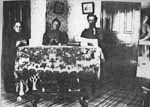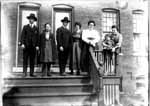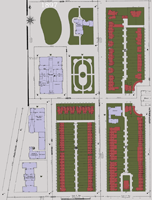The Spanish Flu
You are at Home -> The People of Pullman -> Pullman and the Spanish Flu Epidemic of 1918-1919Pullman and the Spanish Flu Epidemic of 1918-1919
The great flu epidemic of 1918-1919 was a terrible disaster, almost
unprecedented in world history, and yet it is topic overshadowed and
masked by the tragedy of World War I. In looking through issues of the
Pullman Car Works Standard of the time, it is interesting to see the
effects that the flu had on Pullman. Interspersed with the history of
the plague are anecdotes from the Standard.
The Spanish flu, as it is commonly known, was a category 5 influenza
pandemic that claimed more people than the Black Plague. Between 50 and
100 million people died, some 5% of the world's population, and as many
as 25% suffered from it. In contrast, the military and
civilian deaths in World War I were about 20 million. It was first
noticed at Fort Riley, Kansas, on March 11, 1918. Scientists researching
the topic today believe that the disease started as a virulent strain of
Avian Flu and rapidly jumped to humans. It is called the Spanish Flu
because it was most widely reported in neutral Spain, which was free
from wartime news blackouts and as a result had a much freer press. The
only place in the entire world that was not affected by the flu was the
island of Marajo at the mouth of the Amazon River in Brazil.
From the Standard:
The wife of Ernest Bradley died of the influenza on October 13th, and
the boys of the Iron Machine Shop, where he was employed, made up a fine
purse for him as a token of their sympathy and esteem.
Charlie Yucis, of the Iron Machine Shop, died on October 15th and his
sister also passed away the same day, both through influenza.
The flu followed a peculiar infection and fatality pattern: the ones
affected by the flu were mostly the healthy and young adults. It also
struck hardest in the summer and fall, as opposed to most flus which
are worse in the winter. The disease struck with terrifying rapidity.
Healthy people were suddenly ill on one day and die the next. Many
of the deaths resulted from complications of pneumonia.
From the Standard:
Mark Fiezeko, a riveter in the Freight Department, passed away on
Monday, October 7th; his wife and child also died on Tuesday, October
15th, all from pneumonia.
E. L. Wood, leader of the Rivet Makers at the Freight Department,
passed away on Friday, October 11th, after a week's sickness with
pneumonia.
The flu first came to Chicago on September 27, 1918. Within 2 weeks, it
had spread throughout the state. Chicago experienced an average of
12,000 new cases and 2,200 deaths a week. The city ran out of
hearses. People were not allowed on streetcars without protective masks;
the many funeral services were not allowed to be held in churches, and
the number of mourners was severely limited.
Assuming that Pullman followed the average mortality rate of the rest of the
city, in a population (both in the town and at the factory) of 10,000,
500 people died during the epidemic. The names of the deceased that we do know are:
- Wife of Ernest Bradley
- Charlie Yucis and his sister
- Mark Fiezeko, his wife, and child
- E. L. Wood
- The infant child of D. B. Richards
- The adult daughter and infant daughter of George Des Forges
- Des Forges' brother, Hubert Des Forges
- P. J. Noteware
- J. L. Melgren
- The child of W. J. Nydam
THE PULLMAN HISTORY SITE

More Information About the People of Pullman
The People of Pullman
The Pullman House History Project

Arranged by:
Name
Address
Occupation
Birthplace
People of Color
Maps of Pullman
Images of Pullman People
Images of Pullman people
Other Pullman-Related Sites
- Historic Pullman Garden Club - An all-volunteer group that are the current stewards of many of the public green spaces in Pullman. (http://www.hpgc.org/
- Historic Pullman Foundation - The HPF is a non-profit organization whose mission is to "facilitate the preservation and restoration of original structures within the Town of Pullman and to promote public awareness of the significance of Pullman as one of the nation's first planned industrial communities, now a designated City of Chicago, State of Illinois and National landmark district." (http://www.pullmanil.org/)
- The National A. Philip Randolph Pullman Porter Museum is a 501(c)3 cultural institution. Its purpose is to honor, preserving present and interpreting the legacy of A. Philip Randolph, Pullman Porters, the Brotherhood of Sleeping Car Porters and the contributions made by African-Americans to America's labor movement. ((http://www.nationalpullmanportermuseum.com/)
- Pullman Civic Organization - The PCO is a strong and vibrant Community Organization that has been in existence since 1960. (http://www.pullmancivic.org/)
- Pullman National Monument - The official page of the Pullman National Park. (https://www.nps.gov/pull/)
- South Suburban Genealogical & Historical Society - SSG&HS holds the Pullman Collection, consisting of personnel records from Pullman Car Works circa 1900-1949. There are approximately 200,000 individuals represented in the collection. (https://ssghs.org/)
- The Industrial Heritage Archives of Chicago's Calumet Region is an online museum of images that commemorates and celebrates the historic industries and workers of the region, made possible by a Library Services and Technology Act grant administered by the Illinois State Library. (http://www.pullman-museum.org/ihaccr/)
- Illinois Digital Archives (IDA) is a repository for the digital collections libraries and cultural institutions in the State of Illinois and the hosting service for the online images on this site. (http://www.idaillinois.org/)

